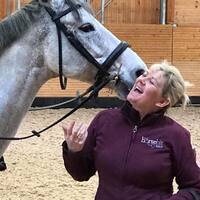As a bitting specialist with over 20 years of experience, one of the most common questions we're asked is "I’ve bought a new horse what bit do I use?". Most people think that when buying a horse they would automatically continue to be ridden in the bit that it was previously ridden in or was tried in, however, this is not always the case. What is important is to give your new four-legged friend time to settle in and adjust to its new routine and surroundings and get to know their new stable mates before we can start to look at creating, improving or establishing the contact.
On many lecture demos, I often ask "Where does the horse engage from first?" and I could pretty much bet my house, career, and chocolate daxie Daisy that the answer would be the hind end. This is not the case though because it is the brain that always engages first and if it is distracted by new surroundings, other horses or unsettled routines we are unlikely to be able to see a true picture of what we need to do to achieve our goal.
What assessments should a new horse have before starting ridden work?
Dental checkup
Next on the list of things we must look at is the teeth. We need to ensure that we have a good set of well-kept teeth that are balanced and with no sharp edges. It is impossible to expect a horse to be able to ride in a nice relaxed outline if the jaw is unable to move smoothly with additional pressures in the TMJ, etc, created by ramps or out-of-balance cheek teeth. It is always advisable to ensure that you have your new horse checked by a qualified Equine Dental Technician and these can be found at
baedt.com.
A physical checkup
Once you know the mouth is in good order and we have a clean bill of health, the next step is to look at the back and the overall musculoskeletal system. The horse must be comfortable and trouble-free through its back, neck, and hind before starting any ridden work. We often see horses evading the bit by sticking the tongue out or trying to get the bit over the top due to too much pressure in the mouth, which after further investigation, is actually related to hind end issues. A typical injury that shows up in this fashion is back suspensory damage. It would be very unfair of us to attempt to re-bit a horse to correct a tongue issue that is actually secondary to a bigger health issue. Not to mention that it would obviously be impossible for a change of bit to fix any issue, it would only mask the problem or make it less obvious, which would again be unfair to your horse.
A saddle fitting
Once we are happy the horse is sound, fit, and ready to crack on, the final step is to check that we have a correctly fitting saddle. Like a sprinter with their running shoes, if they don’t fit properly, we are not going to be able to achieve the best results. Your horse needs freedom of movement under saddle to perform and give good feedback. Again, it is always advisable to ensure that you have your new horse checked by a professional, you can find a list of master saddlers can be found at
mastersaddlers.co.uk.
With all the pre-bitting checks done we can now start to look at finding the bit for the job. So on that cliffhanger… my next instalment we will look at the whys and wherefores of changing bits in a new horse and why its previous bit may not be the right solution.

Ema Odlin-Baxter - The Horse Bit Shop
Senior Bitting Advisor
Published on 05-04-2024
Ema Odlin-Baxter is the Senior Bitting Advisor at the UK’s largest independent bit specialists and bit bank service, The Horse Bit Shop. Established in 2004 the Horse Bit Shop has led the field in bit trialling, advisory, clinics and lecture demonstrations with Ema as HBS’s Chef d'Equipes. Ema is also registered with the Equine Fitters Council
An accomplished horsewoman, Ema has been in the saddle since 5 years old achieving a healthy competition career in many disciplines. Currently filling her stables with some hot-headed showjumpers, she is a keen ambassador for good schooling techniques and the happy horse approach. In her professional career, Ema joined the equestrian world through her sales, marketing and design input roles at Fairfax Saddle Makers before following her passion and talent as a bitting specialist. With a client base covering all equine disciplines, Ema has been a key part in the success of some high-end showjumpers, eventers, dressage and even horseracing portfolios but is just as keen to help with the recreational riders’ problems. Ema, along with her team at the Horse Bit Shop has a reputation for going that extra mile, as fellow horse riders and owners they all appreciate first-hand what it is to have a contact and know how important it is to have the right bit.
Over the years Ema along with her sidekick Vicky Marshall (also a bitting specialist at HBS) has worked alongside the likes of Dale Myler, Heather Hyde, Christoph Augsten, Bomber Nel, Teun and Baz Van Riel to enhance her education in lorinery whilst actively been involved with British Equestrian Trade Association (BETA), British Association of Equine Dental (BAEDT), World Wide Dentistry Association, Society of Master Saddlers not to mention the Pony Club, British Showjumping, Bishop Burton Agricultural College, Askham Bryan to both further her training and education but that of members and students alike through her demos and lectures.
Ema’s engineering and product development background has also come in useful and played a large part in her active role with likes of Stubben Steeltec, Lorinzini, Jeffries, Trust, Horsewear and Sprenger working alongside them to innovate, research and improve the product ranges to fill voids in the current market selection. Furthermore, Ema is working with the Materials and Engineering Research Institute at Sheffield Hallam University testing and researching current bits available on the market and the advantages and disadvantages to the horse of the metals and materials being used.




